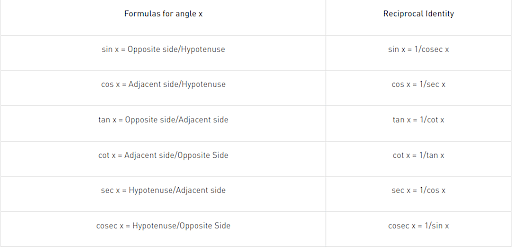Let $\alpha$ and $\beta$ be real numbers such that $-\frac{\pi}{4}<\beta<0<\alpha<\frac{\pi}{4}$. If $\sin (\alpha+\beta)=\frac{1}{3}$ and $\cos (\alpha-\beta)=\frac{2}{3}$, then the greatest integer less than or equal to $\left(\frac{\sin \alpha}{\cos \beta}+\frac{\cos \beta}{\sin \alpha}+\frac{\cos \alpha}{\sin \beta}+\frac{\sin \beta}{\cos \alpha}\right)^2$ is ____.
Solution and Explanation
Given :
\(\sin(\alpha+\beta)=\frac{1}{3}\) and \(\cos(\alpha-\beta)=\frac{2}{3}\)
\(\left(\frac{\sin \alpha}{\cos \beta}+\frac{\cos \beta}{\sin \alpha}+\frac{\cos \alpha}{\sin \beta}+\frac{\sin \beta}{\cos \alpha}\right)^2\)
\(=(\frac{\cos(\alpha-\beta)}{\sin\beta\cos\beta}+\frac{\cos(\alpha-\beta)}{\sin\alpha.\cos\alpha})^2\)
\(=\left(\frac{4}{3} \left\{\frac{1}{\sin2\beta}+\frac{1}{\sin2\alpha}\right\}\right)^2\)
\(=\frac{16}{9}\left(\frac{2\sin(\alpha+\beta).\cos(\alpha-\beta)}{\sin2\alpha.\sin2\beta}\right)^2\)
\(=\frac{16}{9}(\frac{4.\frac{1}{2}.\frac{2}{3}}{\cos(2\alpha-2\beta)-\cos(2\alpha+2\beta)})^2\)
\(=\frac{16}{9}\left(\frac{\frac{8}{9}}{2\cos^2(\alpha-\beta)-1-1+2\sin^2(\alpha+\beta)}\right)^2\)
\(=\frac{16}{9}(\frac{\frac{8}{9}}{\frac{8}{9}+2+\frac{2}{9}})\)
\(=\frac{16}{9}\)
\(=1\)
Therefore, the correct answer is 1.
Top Questions on Some Applications of Trigonometry
- A ladder 7 m long makes an angle of 30\(^\circ\) with the wall. Find the height of the point on the wall where the ladder touches the wall.
- Bihar Board X - 2025
- Mathematics
- Some Applications of Trigonometry
- The angle of elevation of the top of a tower at a distance of 10 m from its base is 60\(^\circ\); then the height of the tower is
- Bihar Board X - 2025
- Mathematics
- Some Applications of Trigonometry
- A kite is at a height of 30 m from the earth and its string makes an angle 60\(^\circ\) with the earth. Then the length of the string is
- Bihar Board X - 2025
- Mathematics
- Some Applications of Trigonometry
- The shadow of a tower, when the angle of elevation of the sun is $30^\circ$, is $50$ m longer than when the angle of elevation was $60^\circ$ on the plane ground. Find the height of the tower.
- UP Board X - 2025
- Mathematics
- Some Applications of Trigonometry
- Let $$ \alpha = \frac{1}{\sin 60^\circ \sin 61^\circ} + \frac{1}{\sin 62^\circ \sin 63^\circ} + \cdots + \frac{1}{\sin 118^\circ \sin 119^\circ}. $$ Then the value of $$ \left( \frac{\csc 1^\circ}{\alpha} \right)^2 $$ is \rule{1cm}{0.15mm}.
- JEE Advanced - 2025
- Mathematics
- Some Applications of Trigonometry
Questions Asked in JEE Advanced exam
- Consider a star of mass $ m_2 $ kg revolving in a circular orbit around another star of mass $ m_1 $ kg with $ m_1 \gg m_2 $. The heavier star slowly acquires mass from the lighter star at a constant rate of $ \gamma $ kg/s. In this transfer process, there is no other loss of mass. If the separation between the centers of the stars is $ r $, then its relative rate of change $ \frac{1}{r} \frac{dr}{dt} $ (in s$^{-1}$) is given by:
- JEE Advanced - 2025
- Gravitation
- A projectile is thrown at an angle of \(60^\circ\) with the horizontal. Initial speed is \(270\, \text{m/s}\). A linear drag force \(F = -CV\) acts on the body. Find the horizontal displacement till \(t = 2\) seconds. Given \(C = 0.1\, \text{s}^{-1}\).
- JEE Advanced - 2025
- Projectile motion
The reaction sequence given below is carried out with 16 moles of X. The yield of the major product in each step is given below the product in parentheses. The amount (in grams) of S produced is ____.

Use: Atomic mass (in amu): H = 1, C = 12, O = 16, Br = 80- JEE Advanced - 2025
- Organic Chemistry
Let $ \mathbb{R} $ denote the set of all real numbers. Then the area of the region $$ \left\{ (x, y) \in \mathbb{R} \times \mathbb{R} : x > 0, y > \frac{1}{x},\ 5x - 4y - 1 > 0,\ 4x + 4y - 17 < 0 \right\} $$ is
- JEE Advanced - 2025
- Coordinate Geometry
As shown in the figures, a uniform rod $ OO' $ of length $ l $ is hinged at the point $ O $ and held in place vertically between two walls using two massless springs of the same spring constant. The springs are connected at the midpoint and at the top-end $ (O') $ of the rod, as shown in Fig. 1, and the rod is made to oscillate by a small angular displacement. The frequency of oscillation of the rod is $ f_1 $. On the other hand, if both the springs are connected at the midpoint of the rod, as shown in Fig. 2, and the rod is made to oscillate by a small angular displacement, then the frequency of oscillation is $ f_2 $. Ignoring gravity and assuming motion only in the plane of the diagram, the value of $\frac{f_1}{f_2}$ is:

- JEE Advanced - 2025
- Waves and Oscillations
Concepts Used:
Trigonometric Functions
The relationship between the sides and angles of a right-angle triangle is described by trigonometry functions, sometimes known as circular functions. These trigonometric functions derive the relationship between the angles and sides of a triangle. In trigonometry, there are three primary functions of sine (sin), cosine (cos), tangent (tan). The other three main functions can be derived from the primary functions as cotangent (cot), secant (sec), and cosecant (cosec).
Six Basic Trigonometric Functions:
- Sine Function: The ratio between the length of the opposite side of the triangle to the length of the hypotenuse of the triangle.
sin x = a/h
- Cosine Function: The ratio between the length of the adjacent side of the triangle to the length of the hypotenuse of the triangle.
cos x = b/h
- Tangent Function: The ratio between the length of the opposite side of the triangle to the adjacent side length.
tan x = a/b
Tan x can also be represented as sin x/cos x
- Secant Function: The reciprocal of the cosine function.
sec x = 1/cosx = h/b
- Cosecant Function: The reciprocal of the sine function.
cosec x = 1/sinx = h/a
- Cotangent Function: The reciprocal of the tangent function.
cot x = 1/tan x = b/a
Formulas of Trigonometric Functions:
